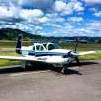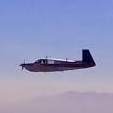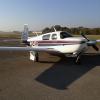All Activity
- Past hour
-
@ameklerHow difficult was the install? My door seal is not great (OEM installed over a decade ago and torn in couple places) and I am deciding between Brown's and the inflatable. What is your overall satisfaction with the Field's one? TIA.
-
Adding a landing/pulsating light to the J and K wingtip
IvanP replied to Steve Dawson's topic in Modern Mooney Discussion
The Whelen LED recog lights are awesome. I put them on my Bravo after seeing what the old style halogens can do to the wingtip lens (fortunately, it was not on my plane). Easy drop-in install and resonably priced (in aviation terms, anyway). Pulsing them may be anice addition. -
N98AK joined the community
- Today
-

Help settle marital paint scheme dispute!
Hank replied to emillerslo's topic in Modern Mooney Discussion
Long time no see Anthony either! Welcome back to both of you! -
Some of us do not have "low fuel lights" except in our ground vehicles. And I've had as many as five (5!) reroutes on what should have been a simple 505nm direct flight. (Three were due to MOAs going hot just before I entered them, and once when I was 5 miles inside the border.) That trip ended up at just over 4.5 hours. While I didn't run the tank dry, I did take it to 2.5 hours (26 gal per tank, no LOP with my carb). I felt better knowing I had at least 1.5 hours, probably 2 hours, remaining in the last tank while still a state away from landing. Having run my tanks dry before, I had a good idea how long I could trust it before needing to watch the Fuel Pressure needle, and that made me feel a lot better.
-
Bem joined the community
-

Adding a landing/pulsating light to the J and K wingtip
Pinecone replied to Steve Dawson's topic in Modern Mooney Discussion
To give credit where is it due, IIRC, @OSUAV8TER was the one who talked to Whelan about making the LED recog lights and then placed the minimum order so they would actually make a batch. FYI, my 1986 M20K 252 has the tips with the recog lights. I suspect that most every Mooney that came from the factory with the sculpted wingtips have them. The flat tips do not. -
1984 Mooney M20K TSIO-360-LB oil leak/loss of oil pressure
Aaviationist replied to Logwes21's topic in General Mooney Talk
I only looked briefly but I don’t see anything for TCM. I would suspect a call to TCM would result in about the same guidance as Lycoming. -

High carbon monoxide levels…help!
Pinecone replied to IntoTheVhoid's topic in Modern Mooney Discussion
FYI, the OSHA limit for CO exposure is 50 PPM for a 8-hour time weighted average. This means that you average the CO level over a normal 8 hour shift. So 100 PPM is OK for up to 4 hours per day, 200 PPM for 2 hours. If the exposure is longer than 8 hours, the allowable level is lower. So for a double shift (16 hours) the max average is 25 PPM.. NIOSH does recommend a maximum exposure concentration of 200 PPM. All that said, I would not worry too much about a 100 PPM during taxi or even climb. But would worry about a level that high in cruise. -
I can see the value. There is no "right" answer, what works best for you. My personal way is to run the one tank to the low flue light (2.5 -3 gallons) and also plane on having at least 10 gallons in the other tank. But if I really needed to push the range, I would not hesitate to run one dry. The only want I could see my getting to this point is if something like a long XC and someone lands gear up and closes the airport, and I have an unplanned divert.
-
You can't fix everything. But if you were running on the fuller tank, it is very unlikely that it will fail that way at that exact time.
-
I don’t think you can even buy them anymore. At least the “M20” brand. I’ve had it on my plane for >2000 hrs. Belly is clean, but I still don’t fill it to 8. I usually start w/6 plus CG and let it get down to under 5, then add a quart. I’ve seen drips of oil on the left nose gear door. How/should you clean these: taking it off & running solvent thru it? I assume they don’t wear out.
-
I also have a spinner, but am not sure of the part number. I bought an F model that had the SWTA cowl/windscreen/spinner upgrade. It came with what appears to be the factory F model spinner. One of the holes has a little crack. No backing plate, just the spinner. DM me if you want it or more info.
-
GNS430W ILS glide slope antenna replacement for King KA-22
Aerodon replied to Targhee's topic in Avionics/Panel Discussion
And newer receivers are probably much better than old. I would try removing that GS antenna completely and putting in th appropriate splitter and giving it a try. Don -

1984 Mooney M20K TSIO-360-LB oil leak/loss of oil pressure
Ragsf15e replied to Logwes21's topic in General Mooney Talk
Any idea if TCM has that? I’m sure some inspection is wise, but he doesn’t have a lyc. -
Ragsf15e started following LOP/ROP EGT
-
It more depends on how far each is from peak. They should all be around 10-50 degrees lean of their individual peak egt, no matter what their actual numbers are. You will find that egts fall quickly on the lean side of peak, so that split is possible, especially if you don’t have even fuel distribution . What is your gami spread? This is the number of gallons ff you lean between when the first cylinder hits peak egt and tge last hits peak egt. Less than 0.5 is good. Another thought, I flew my F at the same altitudes as you because I’m up in Washington. Peak EGT works well at those altitudes and is not too warm. As long as you are below 75%, which you will be at those altitudes, even with full throttle, peak will work fine and not lose as much airspeed. To get to “peak”, I normally leaned until all 4 cylinders hit peak and then set ff so the last to peak was right at or just slightly lean of peak.
-

GNS430W ILS glide slope antenna replacement for King KA-22
EricJ replied to Targhee's topic in Avionics/Panel Discussion
Yes, there's a little loss in the splitter/diplexer to both the GS and VOR receiver, which can be avoided with a separate GS antenna. As you mention, careful placement of the GS antenna might make it better than the VOR antenna...on a Mooney, maybe. It's all tradeoffs, but it's good that there are options. If the GS is in good working order it will likely not make much difference which approach is taken since those systems generally have a lot of design/link margin. A splitter/diplexer will cause a little bit of range reduction to a VOR receiver, though. -
1984 Mooney M20K TSIO-360-LB oil leak/loss of oil pressure
Aaviationist replied to Logwes21's topic in General Mooney Talk
Mandatory service bulletin. https://www.lycoming.com/sites/default/files/attachments/Action%20to%20Take%20If%20Loss%20of%20Oil%20Pressure.pdf Calls for teardown I don’t see an AD. -

1984 Mooney M20K TSIO-360-LB oil leak/loss of oil pressure
Ragsf15e replied to Logwes21's topic in General Mooney Talk
Any idea what happened yet? Also, what’s your plan going forward with the engine since the oil pressure was so low during the divert? -
Jetdriver started following LOP/ROP EGT
-
A quick question for those of you who have more experience with this than me. I have been experimenting with LOP/ROP operations in my M20F. I live in Utah so I am normally cruising between 8-12k. When I run 25° LOP I end up with almost 100° difference between my highest and lowest EGT (1400 vs 1300). When I run 100° ROP my EGTs are usually within 10° of each other (1250-1270). Is this normal?
-
Good to know.
-
BastianM joined the community
-
I've never tallied the J numbers; only looked at peak production periods in the mid to late 60's. For the J's, what were the significant configuration changes that occurred between 77 to 98 other than interior components, wingtips, the throttle quadrant, that would impact parts availability. I've never seen a parts compatibility list. Other than tribal knowledge, gotta wonder if LASAR or Mooney has a detailed cross reference listing. I'm particularly curious about the Mooney's built in the 90s and whether there have any "special" or very limited production parts. Other than a Predator :>, a perfect late 90's J would probably be my dream Mooney choice.
-
WingedVoyager joined the community
-
GNS430W ILS glide slope antenna replacement for King KA-22
Aerodon replied to Targhee's topic in Avionics/Panel Discussion
I have one of those CI-193 antennas for you, one with a little tab that can be used to mount to a round tube. Another option is to use your existing VOR antenna with the correct splitter to go to your two nav receivers. Use the opportunity to replace at least some of the coax. The separate GS antenna provides a better GS signal, less line of sight shielding and less 'splitting. Aerodon -
this is absolutely where they are going, and foreflight has little to no path for the same application...
-
Indeed. It appears Garmin is continuing to optimize Garmin Pilot for Part 91 and possibly Part 125 operations, while ForeFlight has to keep the wider market of GA, commercial and military operations in mind. I tried to find some reliable numbers on the distribution of EFB users across Parts 91, 125 and 135 but understandably wasn't able to find anything publicly available. Garmin is big enough across their product lines to be able to afford to stay focused on the "niche" of Part 91/125, where Foreflight is more of a one-trick-pony and has to keep their offering relevant to all pilots and operation types. Granted, ForeFlight's one trick is a VERY good one.
-
High carbon monoxide levels…help!
amekler replied to IntoTheVhoid's topic in Modern Mooney Discussion
On our bravo installing a Bob fields inflatable door seal fixed my problem Alan -
AMEN! That was the first question I asked when Garmin released SmartCharts. The answer was essentially that they're looking at how to deploy SmartCharts more broadly and that the Garmin Pilot implementation is the first step. I've already made the transition to using the G3X to review NOS charts, which enabled me to remove the iPad from my yoke. Now I just have my iPhone on a MyGoFlight suction mount attached high on my side window to use for copying clearance and taking notes on the scratch pad, and for auto-recording into my Foreflight logbook. It's always there as a backup as well. I still do my flight planning and briefing on an iPad, and then use my phone to load the flight plan into the airplane. Like @PT20J, once I've briefed the procedure and set up the GTN and G3X I don't need to reference the approach plate anymore. The thought of SmartCharts integration with both the G3X and GTN opens some really cool simplified automation possibilities.






